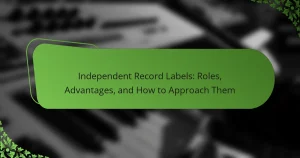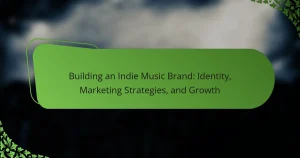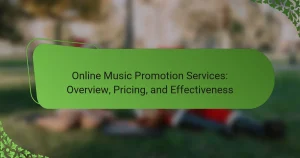Collaborating with other artists enhances creativity and expands audiences. This article explores effective techniques for collaboration, highlights the benefits of shared resources, and showcases notable examples of successful partnerships. By establishing clear communication and a shared vision, artists can navigate challenges and produce innovative work together.
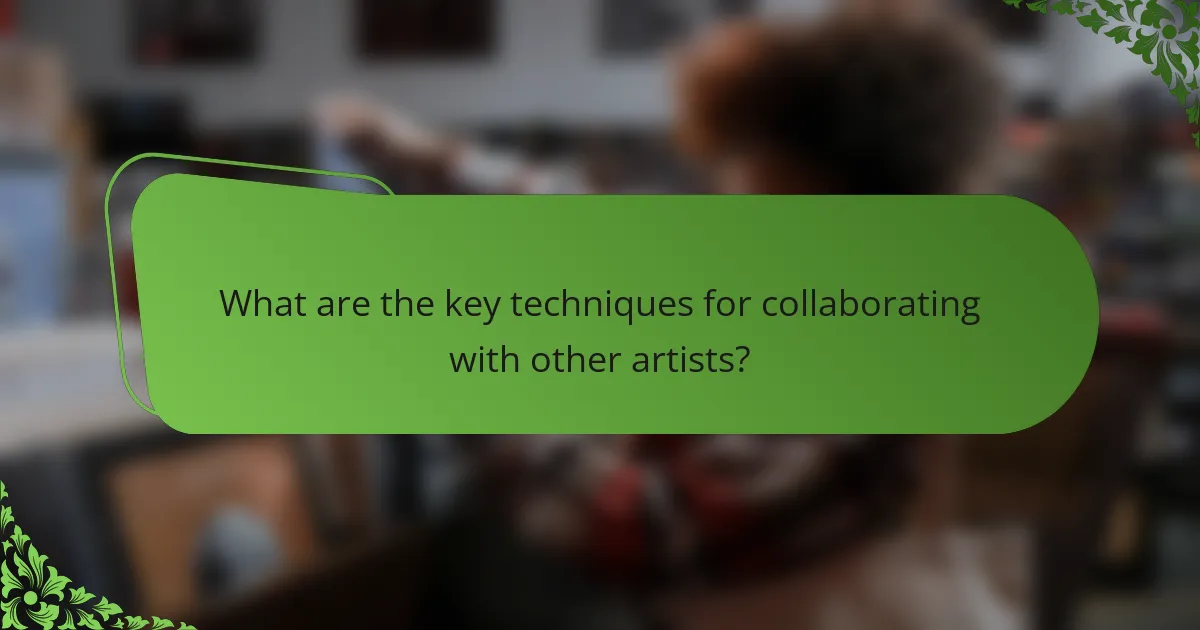
What are the key techniques for collaborating with other artists?
Collaborating with other artists involves techniques such as open communication, setting clear goals, and embracing diverse perspectives. These methods enhance creativity and foster innovation.
Establishing a shared vision helps align efforts and expectations. Utilizing collaborative tools, like shared digital platforms, streamlines the creative process. Regular feedback sessions can refine ideas and strengthen partnerships.
For example, artists can co-create by blending styles, which often leads to unique outcomes. Successful collaborations often result in expanded audiences and increased visibility for all involved.
How do communication styles impact collaboration outcomes?
Communication styles significantly influence collaboration outcomes by shaping interactions and understanding among artists. Effective communication fosters trust and clarity, leading to enhanced creativity and productivity. For example, artists who adopt open and collaborative communication styles often produce more innovative work together. Conversely, misaligned communication styles can create misunderstandings, reducing the effectiveness of collaborative efforts. Therefore, recognizing and adapting to different communication styles is essential for successful collaboration in artistic projects.
Which digital tools facilitate artist collaborations?
Digital tools that facilitate artist collaborations include platforms for communication, project management, and file sharing. Tools such as Slack enhance real-time communication, while Trello organizes project tasks. Google Drive allows easy file sharing and collaborative editing. Additionally, platforms like Discord foster community interaction among artists. These tools streamline workflows and enhance creativity through effective collaboration.
What role does project management play in successful artist partnerships?
Project management is crucial for successful artist partnerships as it ensures clear communication and organized collaboration. Effective project management facilitates the alignment of creative visions, schedules, and resources, enhancing the overall synergy between artists. By establishing timelines and defining roles, project management minimizes misunderstandings and fosters a productive environment. Additionally, it enables artists to track progress and adapt to challenges, ultimately leading to more successful collaborative outcomes.
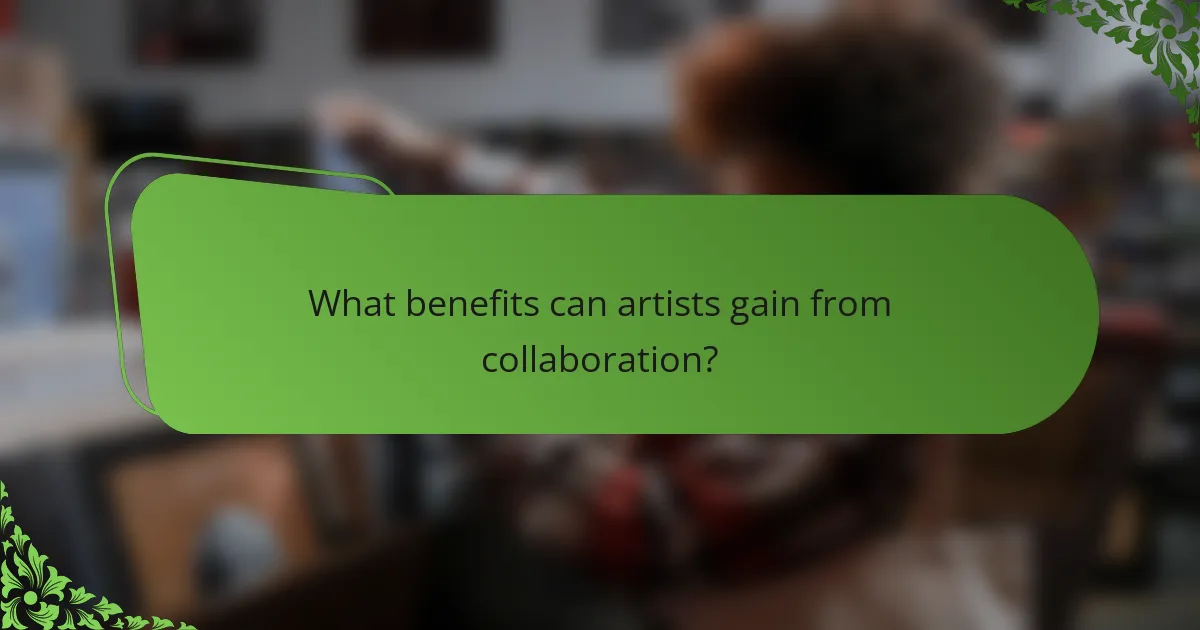
What benefits can artists gain from collaboration?
Artists gain numerous benefits from collaboration, including enhanced creativity, expanded networks, and shared resources. Collaborating fosters new perspectives, leading to innovative ideas. It also allows artists to reach wider audiences by combining their individual followings. Furthermore, shared skills and expertise can improve the quality of the work produced. Collaborative projects often result in unique artistic expressions that may not emerge in solo efforts.
How does collaboration enhance creativity and innovation?
Collaboration enhances creativity and innovation by combining diverse perspectives and skills. This synergy leads to unique ideas and solutions that individual efforts may not achieve.
Collaborating with other artists fosters experimentation and risk-taking. Artists can share techniques, inspiring each other to push boundaries. The exchange of feedback and ideas stimulates growth and exploration.
For instance, joint projects often result in innovative art forms, blending styles and mediums. This cross-pollination of ideas can lead to breakthroughs that redefine artistic norms.
Ultimately, collaboration creates a supportive environment that nurtures creativity, resulting in a richer artistic landscape.
What networking opportunities arise from collaborating with other artists?
Collaborating with other artists creates numerous networking opportunities. Artists can expand their reach by tapping into each other’s audiences, fostering connections that may lead to future collaborations. Joint projects often attract attention from galleries, curators, and media, enhancing visibility. Additionally, sharing skills and resources can lead to innovative techniques and fresh ideas, enriching each artist’s practice. This synergy cultivates a supportive community, essential for growth and inspiration.
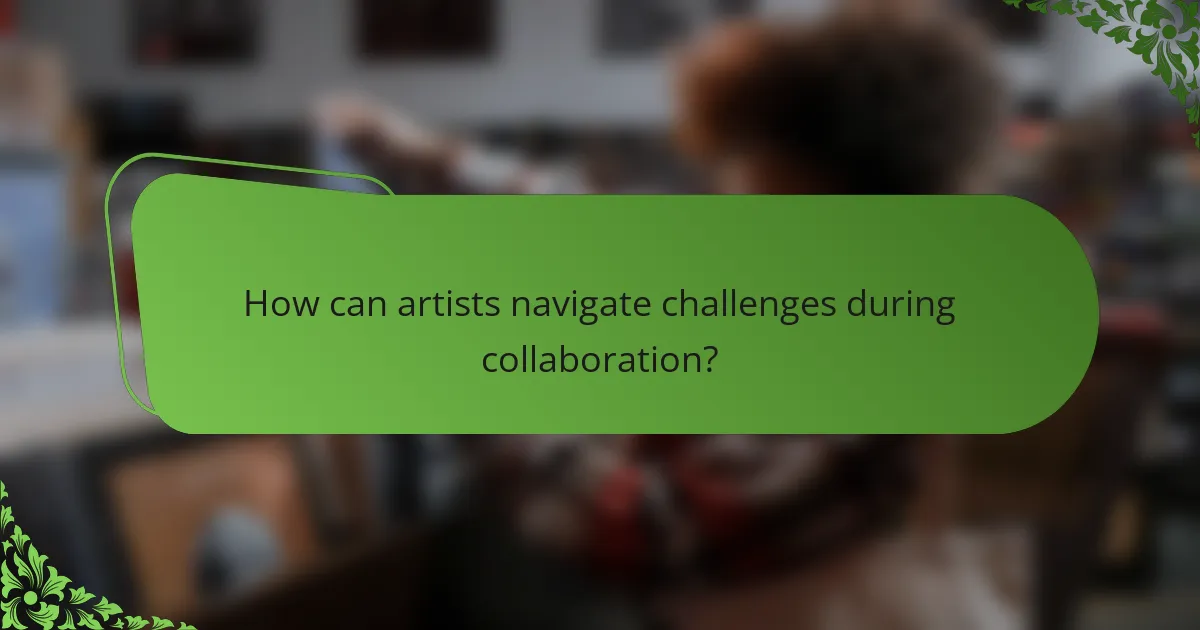
How can artists navigate challenges during collaboration?
Artists can navigate challenges during collaboration by establishing clear communication, setting shared goals, and embracing flexibility. Effective communication fosters understanding and reduces misunderstandings. Setting shared goals aligns the creative vision and ensures all artists work towards a common outcome. Flexibility allows artists to adapt to differing styles and ideas, enhancing creativity. By prioritizing these techniques, artists can overcome obstacles and create successful collaborative projects.
What are common conflicts that arise in artist collaborations?
Common conflicts in artist collaborations include creative differences, communication breakdowns, unequal workload distribution, and differing visions. These issues can hinder the collaborative process and impact the final outcome. Addressing these conflicts early fosters a more productive partnership.
How can artists establish clear roles and responsibilities?
Artists can establish clear roles and responsibilities by defining expectations upfront. Open communication fosters collaboration and minimizes misunderstandings. Setting specific tasks for each participant ensures accountability. Regular check-ins can help adjust roles as needed. Documenting agreements clarifies responsibilities and serves as a reference point.
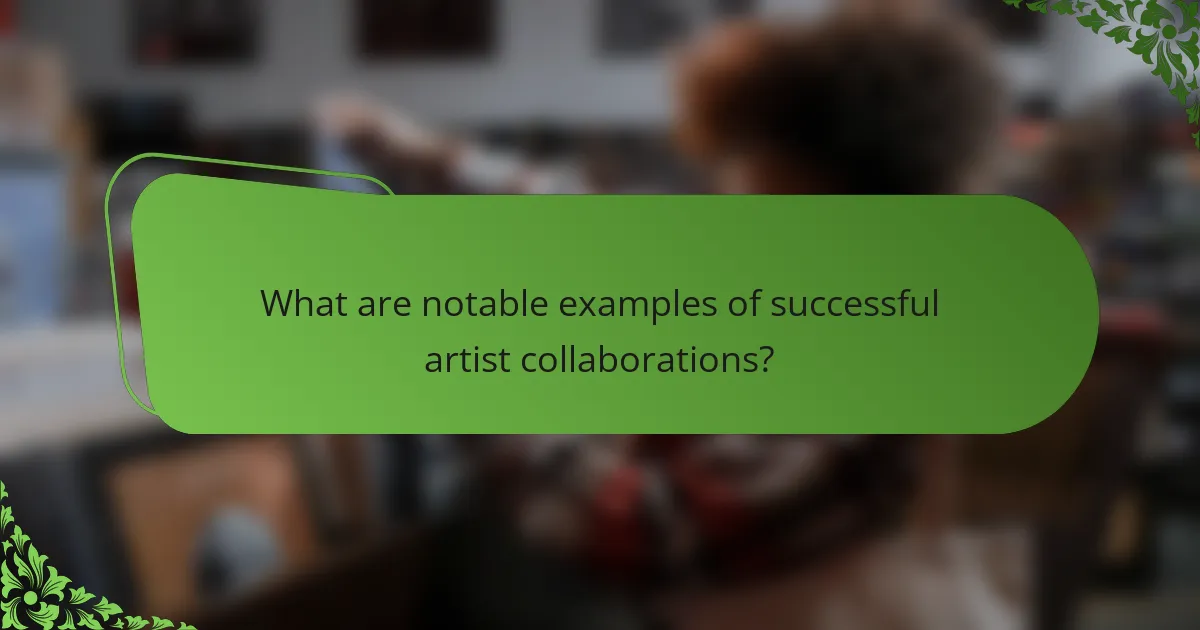
What are notable examples of successful artist collaborations?
Notable examples of successful artist collaborations include the partnership between Beyoncé and Jay-Z, which produced the acclaimed album “Everything Is Love.” Another example is the collaboration between Daft Punk and Pharrell Williams on the hit song “Get Lucky,” showcasing their unique blend of electronic and pop music. Additionally, the collaboration between Travis Scott and Kid Cudi on the album “Kids See Ghosts” highlighted their innovative approaches to hip-hop. These collaborations demonstrate how artists can merge styles and reach broader audiences.
Which collaborations have led to significant cultural impact?
Collaborations between artists often lead to significant cultural impact by merging diverse styles and perspectives. Notable examples include the partnership between David Bowie and Queen, which produced the iconic song “Under Pressure,” blending rock and pop influences. Another influential collaboration was between Jay-Z and Linkin Park, resulting in the “Collision Course” album that fused hip-hop and rock, reaching a wider audience. These collaborations highlight the power of artistic synergy to create new genres and cultural movements.
How do regional influences shape collaborative projects?
Regional influences significantly shape collaborative projects by fostering unique cultural exchanges and blending artistic styles. These collaborations often reflect local traditions, social issues, and community values, enhancing the relevance and resonance of the work. Artists gain new perspectives, access diverse audiences, and create innovative pieces that might not emerge in isolation. For example, a project combining traditional folk art with contemporary techniques can attract attention and engage audiences on multiple levels.
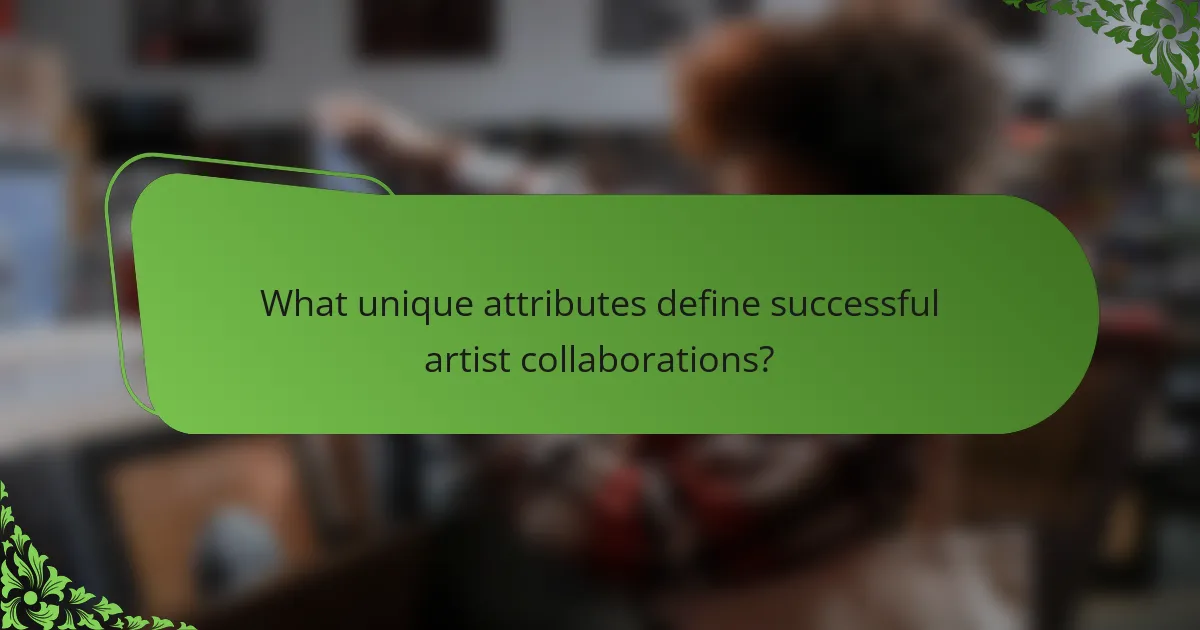
What unique attributes define successful artist collaborations?
Successful artist collaborations are defined by shared vision, complementary skills, and open communication. These unique attributes foster creativity and innovation, leading to impactful outcomes. Collaborators often bring distinct perspectives, enhancing the final work’s depth and appeal. Trust and mutual respect are essential, allowing artists to take creative risks together.
How does the artistic medium affect collaboration dynamics?
The artistic medium significantly influences collaboration dynamics by shaping communication and creative processes. Different mediums foster unique interactions, impacting how artists share ideas and execute projects. For example, visual artists may rely on visual cues, while musicians prioritize auditory feedback. This variation can enhance creativity, as diverse perspectives emerge from varying mediums. Additionally, the medium can dictate the tools and techniques used, affecting the overall collaborative experience. Effective collaboration often requires adaptability to the chosen medium, promoting a deeper understanding among artists.
What differentiates collaborative art projects from solo endeavors?
Collaborative art projects emphasize shared creativity and diverse perspectives, unlike solo endeavors that focus on individual expression. Collaboration fosters innovation through collective brainstorming, combining unique styles and techniques. This synergy often leads to unexpected outcomes and richer artistic experiences. In contrast, solo projects allow for complete creative control but may lack the varied insights that collaboration provides.
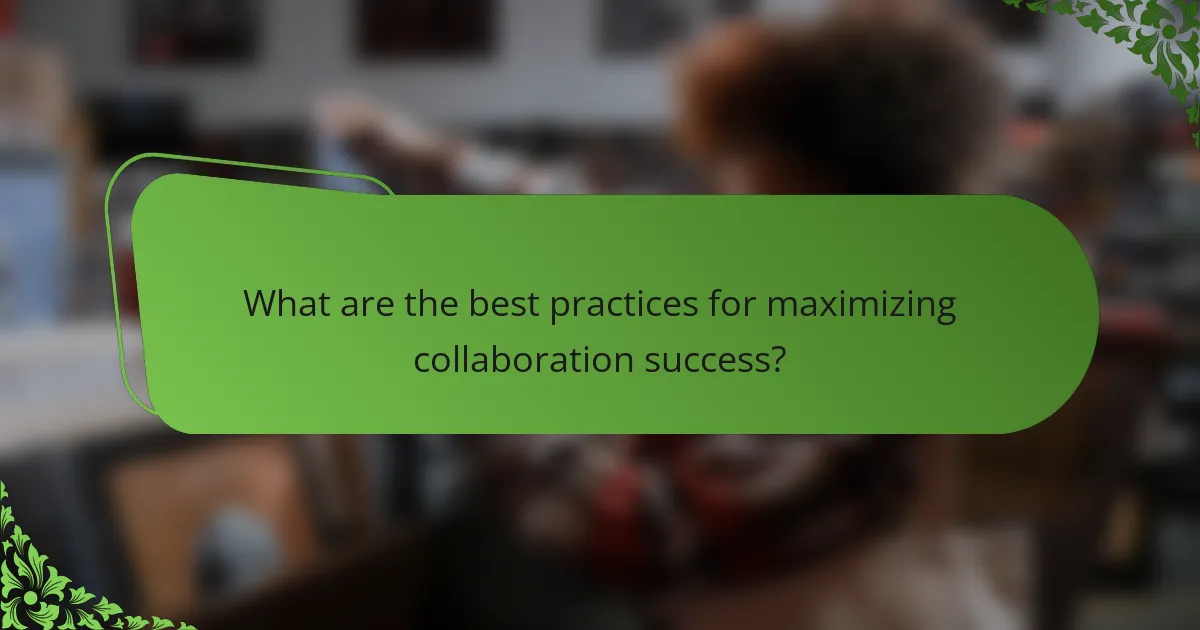
What are the best practices for maximizing collaboration success?
To maximize collaboration success, establish clear communication, set shared goals, and embrace diverse perspectives. These practices enhance creativity, streamline processes, and build trust among artists.
Encourage open feedback and regular check-ins to ensure alignment and address challenges promptly. Utilize collaborative tools and platforms to facilitate seamless interaction and resource sharing.
Fostering a positive environment that values each artist’s unique contributions leads to innovative outcomes and long-lasting partnerships.
What common mistakes should artists avoid when collaborating?
Artists should avoid miscommunication, unclear roles, and lack of trust when collaborating. Fostering open dialogue is essential to prevent misunderstandings. Clearly defining each artist’s responsibilities ensures efficient workflow. Establishing trust promotes a positive environment, allowing creativity to flourish. Regular feedback sessions can help address issues early and keep the collaboration on track.
How can artists effectively evaluate collaboration outcomes?
Artists can effectively evaluate collaboration outcomes by setting clear goals, measuring progress, and soliciting feedback. Establishing specific objectives ensures all parties are aligned. Regularly reviewing milestones helps track contributions and outcomes. Gathering input from collaborators can reveal insights into the effectiveness and impact of the partnership.
